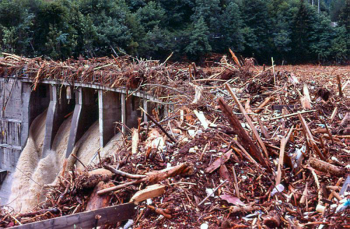Ice and Other Debris: Difference between revisions
No edit summary |
No edit summary |
||
| Line 5: | Line 5: | ||
| [[Image:Palagnedra2.png|350px|x350px|link=https://damfailures.org/case-study/palagnedra-dam-switzerland-1978/]] | | [[Image:Palagnedra2.png|350px|x350px|link=https://damfailures.org/case-study/palagnedra-dam-switzerland-1978/]] | ||
|- | |- | ||
|style="text-align:center; font-size:90%;"| Learn more | |style="text-align:center; font-size:90%;"| Learn more about the impact of debris on the spillway at [https://damfailures.org/case-study/palagnedra-dam-switzerland-1978/ Palagnedra Dam (DamFailures.org)] | ||
|} | |} | ||
Revision as of 03:45, 13 December 2022

|
| Learn more about the impact of debris on the spillway at Palagnedra Dam (DamFailures.org) |
“Each year, ice grows on and disappears from the nation’s rivers and lakes in tune with cycles of nature. Unless the ice causes problems, such as flooding or blocking the arteries of commerce, few people pay more than cursory attention. Because of this, the very great variety of ways in which ice initially forms, grows, and accumulates, and finally disappears, are relatively unknown. Ice processes on lakes are different from those on rivers, and for both lakes and rivers, the size of the water body affects which processes take place. Ice owes its existence to the thermal process of heat transfer, but its evolution is greatly influenced by physical and mechanical processes”.[1]
The formation, movement, and accumulation of ice in rivers and reservoirs at, or around, various hydraulic structures complicates the methods used to predict flooding, sediment transport, and scour, as well as complicates the operation and maintenance of different components of hydraulic structures such as gates, culverts, and bridges.
Effects of ice on gate structures
- “Dam gates are particularly susceptible to freezing in place because of leaking seals and resulting ice buildup, especially if gates are moved infrequently. Hoisting chains, trunnion arms, etc., may become so loaded with ice a to be too heavy for lifting mechanisms”.[1]
Effects of ice on river stage and discharge:
- “A stationary river ice cover, whether an ice sheet or a jam, introduces an additional boundary and therefore increases energy losses. This translates to an increase in stage compared to open-water conditions for the same discharge. Numerical models for river hydraulics must be able to account for the effects of ice if they are to reliably describe river flows and stages. The resistance offered by an ice cover will lead to upstream water storage, resulting in rapid stage rise and possible flooding, and simultaneously will lead to a drop in stage and a discharge deficit downstream from the ice cover. If the stage drop is severe enough, downstream water intakes may become exposes, affecting municipal and industrial water supplies, especially during periods of drought or very low flow”.[1]
Effects of ice on sediment transport and scour
- “The presence of a floating ice cover roughly doubles the wetted perimeter of a wide channel, which in turn modifies the magnitude and distribution of the velocities and, thus, the boundary and internal shear stresses. For a movable bed channel, an ice cover may, therefore, affect the bed sediment transport and the suspended sediment transport characteristics of the stream and modify the channel geometry and the bed regime. For an abrupt thickening of an ice accumulation, such as the toe of an ice jam, there may be significant bed scout because of the deflection of the flow against the bed. When this happens in the vicinity of a riverine structure, such as a bridge pier, the resulting scour may eventually cause structural failure”.[1]
Effects of flooding caused by ice jams
- “River ice jams may contribute to winter and early spring flood damage. Ice blockages in main stems and tributaries cause stages to rise and force water out of the channel over the floodplain, even when discharges are low compared to warm-water floods. Ice jam floods, while usually not as extensive as open-water floods, often take place with little or no warning. The factors and relationships that determine the probability of ice jams and ice jam flooding are more complex than those for open-water flooding. This means that the extensive statistical analysis methods applied to normal flooding phenomena are not readily applicable to ice-related occurrences. Many mitigation measures have been developed for preventing or reducing ice jam floods; these methods may be structural or nonstructural, and they may be deployed on a permanent, advance, or emergency basis”.[1]
Examples
![]() Learn more about the effect of debris on the spillway at Palagnedra Dam (DamFailures.org)
Learn more about the effect of debris on the spillway at Palagnedra Dam (DamFailures.org)
![]() Learn more about the effect of ice during the failure of Spencer Dam (DamFailures.org)
Learn more about the effect of ice during the failure of Spencer Dam (DamFailures.org)
Best Practices Resources
![]() Ice Engineering (EM 1110-2-1612) (U.S. Army Corps of Engineers)
Ice Engineering (EM 1110-2-1612) (U.S. Army Corps of Engineers)
![]() Ice Pressure on Engineering Structures (CRREL III-B1b) (U.S. Army Corps of Engineers)
Ice Pressure on Engineering Structures (CRREL III-B1b) (U.S. Army Corps of Engineers)
Citations:
Revision ID: 5239
Revision Date: 12/13/2022
